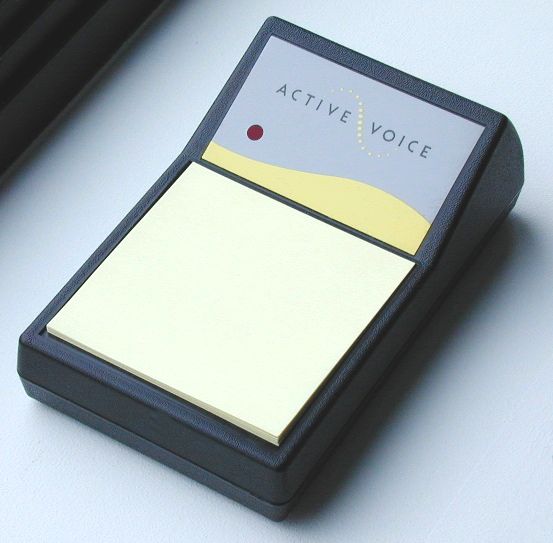
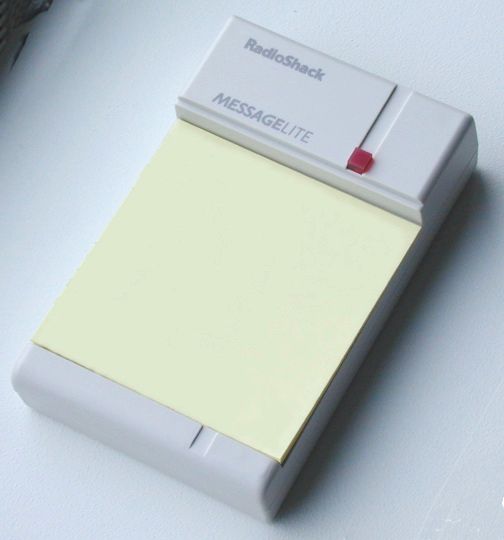
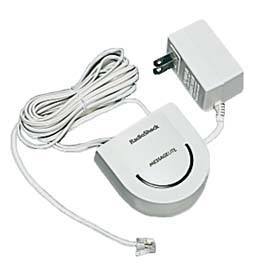
This device was conceived of by Bard Richmond and Richard Aydolotte at Active Voice. I implemented their ideas and added a few of my own along the way. We did a few prototypes, a beta test and eventually, it ended up at RadioShack.
In the late '80's, Active Voice, was big into the small office voicemail market. One of the problems with the Rolm and AT&T PBXs was that unless you had a $200 feature phone, you didn't get a message waiting light, you just got stutter dialtone. For $180 difference in price, a lot of companies were willing to put just a plain 2500 set on the desktop. A number of schemes had been used for putting MWI indicators on 2500 sets, typically involving LEDs or neon lamps and an extra pair of wires. ( As an aside, I did some software work on a PBX from a company called Melco that had a tendency to catch on fire when enough dust accumulated on the 108VAC leads that were used to drive the neon MWI pair )
Anyway, Bard and Richard though that there would be a market for a small simple device that went off-hook periodically and checked for stutter dialtone, and flashed a light or indicator if it was there. Bard's dad ( Martin ) had a tone detector circuit and Bard asked me to develop it into a device that could be sold for under $30.
The first problem was power and the issue of batteries vs. wall-warts. Bard was opposed to both. So since we were developing for the PBX market, I worked out a circuit that would "leach" a milliamp or so out of the on-hook battery supply to charge a 1F super-cap. It also had a 5V in-line zener drop so that as soon as the subscriber went off-hook, the super-cap would also charge from the loop current. This had a few problems as until the subscriber made a phone call, the super-cap wouldn't have enough charge to flash the LED.
I built up a wire-wrap prototype and it worked pretty well. We tried it with Rolm, AT&T, and a few smaller PBXs and it seemed to work fine. We also tried it with 5ESS and 1AESS CO switches and it worked fine with them too. This got Bard and Richard thinking that another big market might be the home voicemail market as caller-ID support for MWI was still rare ( this was '90 or '91 ). So off came the bleed resistor and it became a battery powered device for the home market.
Bard wanted to do a beta test, so I built up 15-20 devices with printed circuit boards and off-the-shelf plastic cases. The MWI case included a space for a "post-it-note" message pad, which I was rather proud of ( I think we could have also gotten a design patent on that, but it probably wasn't worth it ). We had all the beta testers sign non-disclosure agreements and sent the units off for test. The testers loved the units although we did have a problem with people who had multiple extensions in their home. The unit was designed for a single line PBX environment so it used loop current to detect the off-hook condition. We tweaked a couple of the units to use line voltage to detect the off-hook condition and they worked much better for the people who had multiple extensions in their home.
By this time ActiveVoice and I were on different paths so we parted ways. An engineer ( don't remember his name ) was hired on to continue the hardware work. He converted my design which was based on 4000 series CMOS glue logic to a PIC microcontroller. We started a patent application in the early 90's and it was issued in 1994 ( US #5,327,493 ). In 1997, the patent was re-examined and a few more claims were added ( revised ). Interestingly, US West strongly objected to the issuing of the patent for the device claiming that the load of all those devices on their network would overload their switches. I got to work some years later with their representative ( Tom Comfort ) who found it quite amusing to actually meet the inventor of the device they were fighting. Of course it wasn't the switching load that they were worried about, it was all the extra loop current draw that was going to cost them the extra money that concerned them. US West also went to the FCC and got them to put rules in place about how often devices of this type could check for stutter dialtone. If I can find links to the FCC decisions on the matter I'll add them here.
I was quite surprised a few years later when I happened to look in a telephone equipment catalog and found what looked like a duplicate of the prototype available for sale. A few months later the same version showed up in the Radio Shack catalog. I headed down to the nearest store and found they offered both a battery powered and a wall-wart version of the MWI.
One of the design decisions I had made early on in the project was to use four batteries instead of three. I did this because I incorrectly thought that this would give me more lifetime out of the batteries. After the prototypes were fabricated I realized my mistake, that a higher operating voltage just increases the current draw and therefore shortens the battery life. In retrospect, three was the proper number of batteries to use. Much to my chagrin, opening up the Radio Shack version revealed a battery compartment designed for four batteries! Oh well, I guess they are also in the business of selling batteries.
Recently, I've been involved in a court case involving defending the patent. One of the ugly things about patents is that you have to defend them in court. In this case, ActiveVoice hired a Bay Area IP legal firm to represent them and go after a telephone equipment manufacture that was flagrantly infringing on the patent. I met with the attorneys and told them the history of the message waiting indicator. I've kept detailed notebooks of my work since high school, and gave the attorneys copies of these that recorded all of the work and meetings surrounding the invention of this device. After copies of these notebooks were sent to the attorneys for the equipment manufacture, they decided that it was time to settle. The case was settled out of court within weeks.



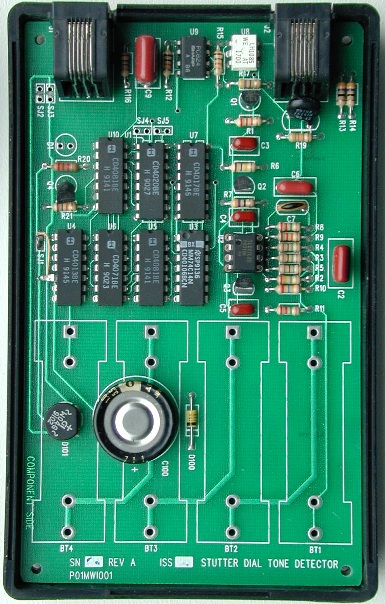
And second the battery powered version suitable for PSTN connection ( batteries not
included! ):
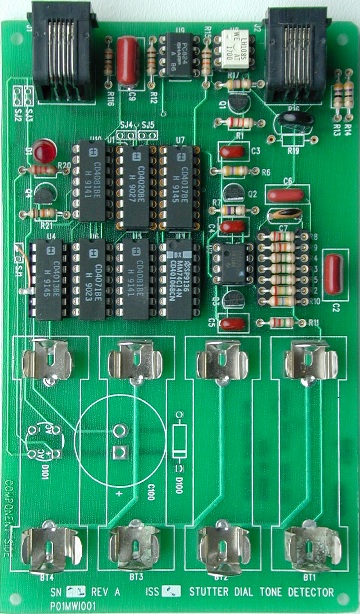
Back to the Work Page
Back Home